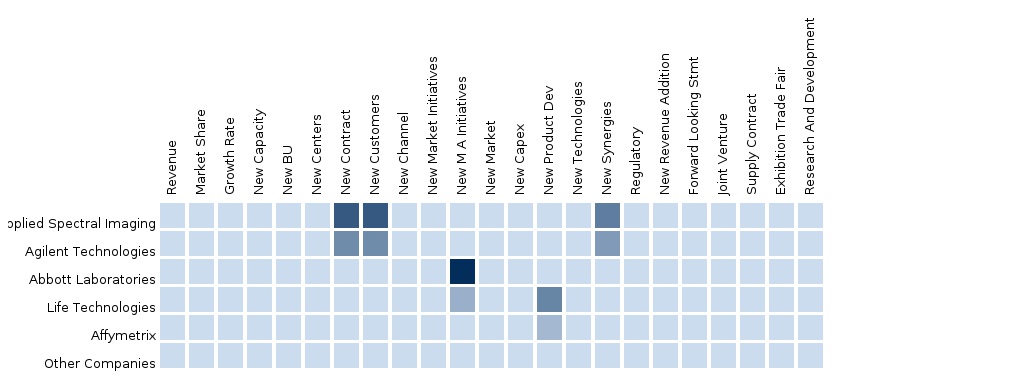The in-situ hybridization technique is used to diagnose gene-related diseases. It is also employed in the clinical research for prenatal diagnosis of inherited chromosomal aberrations and postnatal diagnosis of carriers of genetic diseases.
In-situ hybridization includes combination of two complimentary strands of DNA. The fluorescence in-situ hybridization (FISH) technique makes use of fluorescent labeled DNA probes to discover and effectively examine gene or chromosome abnormalities. The technique works by denaturing the sample DNA, and then adding fluorescent labeled probe of interest to hybridize the DNA. With the help of fluorescent microscope, the probe signal is observed and the sample DNA is scored for the presence or absence of signal.
The North American in-situ hybridization accounts for the largest market share, globally in 2013. This market was valued at $311 million in 2013, and is expected to grow at a CAGR of 11.2% from 2014 to 2019. Advancements made in the use of automated data collection techniques and employment of high-sensitivity detection methods are considered as significant factors driving the demand of in-situ hybridization market.
This market research report offers a comprehensive analysis of market share, value chain analysis, and market metrics including drivers, restraints, and upcoming opportunities. Additionally, it also highlights market revenues of leading companies operating in the in-situ hybridization market segment. Insightful data is mainly derived from key facts, annual financial information from SEC filings, annual reports and interviews with industry experts, key opinion leaders such as CEOs, directors, and marketing executives. The report also lists down key players of the North America in-situ hybridization market, along with information on their product portfolio, company financials, recent developments, and growth strategies.
1 Introduction
1.1 Objective of the Study
1.2 Market Segmentation & Coverage
1.3 Stakeholders
2 Research Methodology
2.1 Integrated Ecosystem of In-situ Hybridization Market
2.2 Arriving at the In-situ Hybridization Market Size
2.2.1 Top-Down Approach
2.2.2 Bottom-Up Approach
2.2.3 Demand Side Approach
2.2.4 Macro Indicator-Based Approach
2.3 Assumptions
3 Executive Summary
4 Market Overview
4.1 Introduction
4.2 North America In-situ Hybridization Market: Comparison with Parent Market
4.3 Market Drivers and Inhibitors
4.4 Key Market Dynamics
4.5 Demand Side Analysis
4.6 Vendor Side Analysis
5 In-situ Hybridization Market, By Application
5.1 Research Methodology
5.2 Introduction
5.3 Demand Side Analysis
5.4 Vendor Side Analysis
5.5 In-situ Hybridization in In Vitro Diagnostics, By Geography
5.6 In-situ Hybridization in Drug Discovery, By Geography
5.7 In-situ Hybridization in Academics, By Geography
5.8 In-situ Hybridization in Agrigenomics, By Geography
5.9 In-situ Hybridization in Personalized Medicine, By Geography
5.10 In-situ Hybridization in Other Applications, By Geography
5.11 Sneak View: North America Genomics Market, By Application
6 In-situ Hybridization Market, By Product
6.1 Research Methodology
6.2 Introduction
6.3 North America In-situ Hybridization Market, Type Comparison with Genomics Market
6.4 North America In-situ Hybridization Reagents Market, By Geography
6.5 North America In-situ Hybridization Instruments Market, By Geography
6.6 North America In-situ Hybridization Services Market, By Geography
6.7 Sneak View: North America Genomics Market, By Product
7 In-situ Hybridization Market, By Technology
7.1 Research Methodology
7.2 Introduction
7.3 North America In-situ Hybridization Market, Type Comparison with Genomics Market
7.4 North America FISH Market, By Geography
7.5 North America CGH Market, By Geography
7.6 North America Other In-situ Hybridization Technologies Market, By Geography
7.7 Sneak View: North America Genomics Market, By Technology
8 In-situ Hybridization Market, By Geography
8.1 Research Methodology
8.2 Introduction
8.3 Vendor Side Analysis
8.4 U.S. In-situ Hybridization Market
8.4.1 U.S. In-situ Hybridization Market, By Application
8.4.2 U.S. In-situ Hybridization Market, By Type
8.5 Canada In-situ Hybridization Market
8.5.1 Canada In-situ Hybridization Market, By Application
8.5.2 Canada In-situ Hybridization Market, By Type
8.6 Mexico In-situ Hybridization Market
8.6.1 Mexico In-situ Hybridization Market, By Application
8.6.2 Mexico In-situ Hybridization Market, By Type
8.7 Sneak View: North America Genomics Market, By Geography
9 Competitive Landscape
9.1 In-situ Hybridization Market Concentration Analysis
9.2 Company Presence in In-situ Hybridization Market, By Type
9.3 Mergers & Acquisitions
9.4 Other Expansion
9.5 New Synergies
10 In-situ Hybridization Market, By Company
10.1 Agilent Technologies
10.1.1 Overview
10.1.2 Key Financials
10.1.3 Product and Service Offerings
10.1.4 Related Developments
10.1.5 MMM Analysis
10.2 Life Technologies
10.2.1 Overview
10.2.2 Key Financials
10.2.3 Product and Service Offerings
10.2.4 Related Developments
10.2.5 MMM Analysis
10.3 Affymetrix
10.3.1 Overview
10.3.2 Key Financials
10.3.3 Product and Service Offerings
10.3.4 Related Developments
10.3.5 MMM Analysis
10.4 Abbott Laboratories
10.4.1 Overview
10.4.2 Key Financials
10.4.3 Product and Service Offerings
10.4.4 Related Developments
10.4.5 MMM Analysis
10.5 Applied Spectral Imaging
10.5.1 Overview
10.5.2 Key Financials
10.5.3 Product and Service Offerings
10.5.4 Related Developments
10.5.5 MMM Analysis
11. Appendix

Please fill in the form below to receive a free copy of the Summary of this Report
Please visit http://www.micromarketmonitor.com/custom-research-services.html to specify your custom Research Requirement














